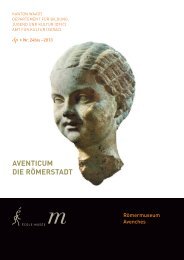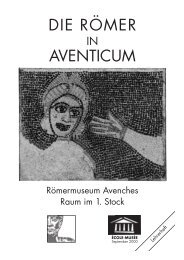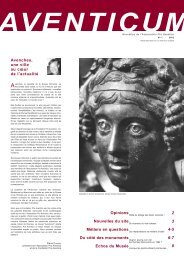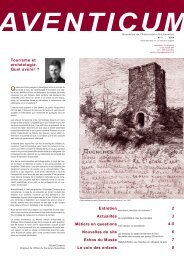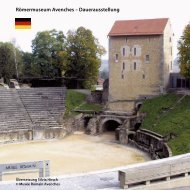Avenches – Roman Museum – Permanent Exhibition
Avenches – Roman Museum – Permanent Exhibition
Avenches – Roman Museum – Permanent Exhibition
You also want an ePaper? Increase the reach of your titles
YUMPU automatically turns print PDFs into web optimized ePapers that Google loves.
First Floor Trade and Money<br />
The Monetary System from the 1 st to the 3 rd Century<br />
7. Gladiator armed with a trident and a knife. Terra-cotta oil lamp.<br />
8. Two gladiators fighting each other. Terra-cotta oil lamp.<br />
9. Bowl in terra sigillata, with gladiator scene. Late 1st century AD.<br />
10. Ceramic drinking vessel decorated with a bull. Second half of the 2nd century AD.<br />
11. Hunting scene. Terra-cotta oil lamp.<br />
12. Ceramic pottery bowl, decorated with a lion. Second half of the 2nd century AD.<br />
Music was ever-present in everyday <strong>Roman</strong> life. It not only accompanied plays<br />
and combat, but also public and private festivities, banquets, weddings, funerals,<br />
triumphal parades, processions and religious sacrifices.<br />
The organ fragments (display case 14, no. 7) discovered in Aventicum are<br />
particularly important since, to date, only three instruments of this type have been<br />
found within the boundaries of the <strong>Roman</strong> Empire.<br />
Display case 14<br />
1-2. Small bronze cymbals.<br />
3. Arm of a lyre (?) made of antler. Early 1st century AD.<br />
4. Sitting Cupid, playing the cithara. Ivory medallion.<br />
5. Sitting Cupid, playing the cithara. Terra-cotta oil lamp (2).<br />
6. Ivory cithara. This object may have served as a decorative element on a piece of<br />
furniture.<br />
7. Bronze parts of a water organ (3). Chest and bronze key showing the figure VIIII, which<br />
identifies it as the ninth key. Derrière la Tour Palace.<br />
8. Plectrum, probably made of tortoise shell, used for playing the strings of a lyre or<br />
cithara.<br />
9. Right arm of a bronze statue. The thumb and index finger are holding a plectrum in the<br />
shape of a lion’s paw.<br />
10. Right hand of a bronze statue representing a flute player; found in the refuse dump of<br />
a bronze smith.<br />
Trade and Money<br />
(Display case 15)<br />
The Monetary System from the 1 st to the 3 rd Century<br />
Reorganised by Augustus, the monetary system of the <strong>Roman</strong> Empire was<br />
comprised of gold, silver, brass and copper coins. The relationships between<br />
these metals and the coin weights were clearly defined (display case 15, no. 1).<br />
Therefore, the different values of the coins could easily be distinguished (display<br />
case 15, nos. 2-8) by the colour of the metal. The brass coins (sesterces and semis),<br />
for instance, were worth twice as much as the copper coins (as and quadrans).<br />
1<br />
2<br />
3<br />
30<br />
First Floor<br />
13<br />
14<br />
15



